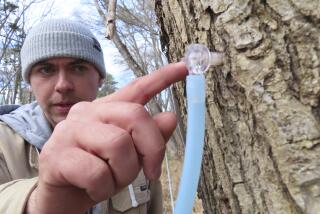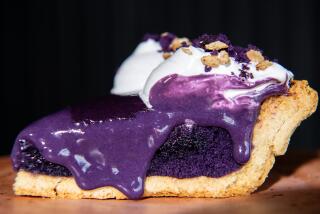Darkness Edible: The Syrups of Winter
- Share via
For much of the country, January is a time of cold, darkness and gloom. And few places are gloomier than the northern parts of New England. The sky is gray; the trees are bare; the snow is deep. Yet with this glum month comes the first harbinger of spring: the flowing sap of the sugar maple tree. And from this sap comes a delicacy unique to North America: maple syrup.
For centuries, the Cree, Algonquin and Ojibwa Indians enjoyed the sweet sap of the sugar maple. They would gash the trees with a hatchet, collect the sap in birch bark buckets and boil it in wooden troughs by adding red-hot stones from the fire. The Colonists brought new refinements to the sugaring process, such as metal spiles (taps) to draw the sap from the tree. (Hatchet slashing tended to kill the tree.) But most important was the introduction of iron and copper vessels for boiling the syrup.
When maple sap leaves the tree, it contains about 4% sugar. Boiling evaporates the water, concentrating the sap’s sweetness. The traditional device for boiling syrup is in a long, flat steel evaporator pan partitioned into a series of chambers. This pan sits on an “arch” or “firebox,” stoked by burning logs or fuel oil. As the syrup thickens, it moves through a series of flues from the back of the evaporator to the front.
It sounds complicated, and it is complicated--not to mention messy, uncomfortable and time-consuming. The sap itself is highly perishable: Ideally, it will be boiled the day it’s collected. A 24-hour delay can mean the difference between a higher grade and an inferior grade of syrup.
*
A typical sugar house has the heat and din of Dante’s proverbial inferno. Eye-stinging smoke rises from the firebox; steam rises from the evaporator. In peak season, the work days last 12 to 14 hours.
Some statistics: It takes 40 years for a maple tree to reach a 10-inch diameter--the size suitable for tapping. (The tree must be 20 inches in diameter to accommodate a second tap.) It takes four trees six weeks to produce enough sap to make a single gallon of maple syrup. Each gallon of syrup requires one (four-foot) log or three gallons of fuel oil to stoke the evaporator. Forty gallons of sap are required to make a single gallon of maple syrup.
The quality of maple syrup is as quirky as the weather. The same tree might produce “Vermont Fancy” one year and Grade B the next. The best syrup tends to be made at the beginning of the season, but climatic conditions, the age and site of the trees, and the sugar maker’s dexterity all contribute to the final product.
“There are three countries that produce maple syrup: Canada, the United States and Vermont,” quips one sugar maker I know. Actually, syrup is made in every state in New England, not to mention Ohio, Michigan, Maryland, Wisconsin, Pennsylvania and New York. But Vermont is the industry leader, both in terms of production and quality control.
As the syrup leaves the evaporator, it is graded by color and density, according to strict standards set by the state. The highest grade is “Vermont Fancy,” a syrup remarkable for its light amber color and delicate flavor. “Grade A medium amber” is slightly darker, but still mild-tasting. “Grade A dark amber” has a slight caramel flavor. “Grade B” is very dark, with a pronounced caramel flavor.
*
Vermonters use the highest grade on pancakes and waffles, deeming Grade B fit only for cooking. But I prefer the robust caramel taste of grade A medium amber to the delicate flavor of Vermont Fancy. In recent years, the traditional square metal cans have given way to rust-resistant plastic jugs.
Maple syrup is delicious on all manner of breakfast fare, from French toast to oatmeal, not to mention pork, ham, and, yes, even ice cream. (I like to warm syrup destined for pancakes and waffles before serving. To prevent it from boiling over, add a tiny piece of butter.) Syrup is the key ingredient for at least two New England specialties: Indian pudding and baked beans.
Unopened, maple syrup will keep indefinitely; it should be refrigerated once the container is opened. (Many Vermonters store their prize syrups in the freezer.) If the syrup should crystallize, you can bring it back to liquid form by placing the can in a pan of simmering water.
So remember, no matter how bleak winter seems, spring is just around the corner. The following pie will bring you sweetness any time of the year.
*
This dulcet dessert is a sort of Yankee pecan pie. The recipe comes from the Hermitage Inn in Wilmington, Vt., where it is prepared with homemade maple syrup.
*
MAPLE-WALNUT PIE
1/2 cup brown sugar, packed
2 tablespoons flour
1 1/4 cups maple syrup
3 tablespoons butter, melted
3 eggs, beaten
1 1/2 teaspoons vanilla
1 (9-inch) pre-baked pie crust
1 cup coarsely chopped walnuts
Combine brown sugar, flour and maple syrup in bowl and whisk until smooth. Beat in melted butter, eggs and vanilla. Spoon filling into crust and sprinkle walnut pieces on top. (They will sink temporarily, but will rise to surface during baking.)
Bake pie at 350 degrees until filling is puffed and set, about 40 minutes. (Wood pick inserted in center will come out clean when pie is done.) Let pie cool to room temperature. Cut into wedges for serving. (Maple-syrup-flavored whipped cream makes wonderful accompaniment.) Makes 8 servings.
More to Read
Eat your way across L.A.
Get our weekly Tasting Notes newsletter for reviews, news and more.
You may occasionally receive promotional content from the Los Angeles Times.






